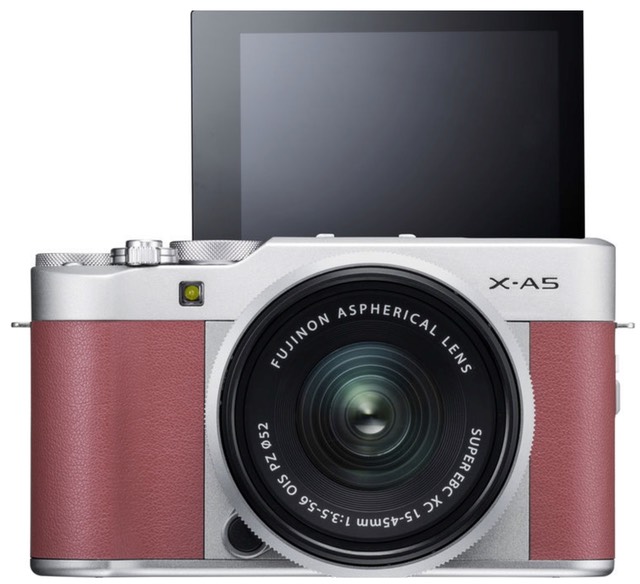
I call this a mini-review because, amazingly, not a lot has changed from the X-A1 or X-A3. I suggest you read my X-A1 review as a starting point.
What’s New?
External changes are few: we get a microphone/remote jack we didn’t have on the previous models. The physical focus mode switch has been removed. Plus you’ll find a new Motion Panorama position on the Mode dial where there used to be a Custom position.
The 3” rear LCD’s now has slightly better touch capabilities. You still get the fully automated switch to selfie mode when you rotate the screen into selfie position, if you want it.

Fortunately, inside there are some changes that make a bigger difference. We get the 24.2mp Bayer-filtered image sensor, and it’s a bit different than the one in the X-A3: on chip phase detection and a faux 4K video mode (up to five minutes worth, probably limited by heat). 4K video is only at 15 fps, so it’s not really useful for many things (though it does allow you to use a Burst Mode to get 8.3mp stills from the 4K stream, and even an 8.3mp focus shift ability). You’ll need a faster card than the previous model to record 4K streams (the new Class 3, even though the slot is UHS-I).
A new image processor is claimed to have 1.5x the performance of the one in the X-A3. Fujifilm also makes claims for improved image quality, as well. High ISO capability increases by one stop.
Battery life is improved a bit to 450 images (CIPA), and the Wi-Fi function now has a Bluetooth component for quick pairing. Meanwhile the built-in flash has lost a bit of power, now down to a GN of 5.7 (meters) from 7.
Physically, the camera hasn’t really changed in size from the previous model, though the weight went up 0.7 ounces (22g).
The camera itself is available in three colors here in the US (may be additional ones overseas): black, brown, or pink leather under a silver upper body. So now we have Pink Pandas! Guess which one I requested?
Funny story: I was shooting with my Pink Panda when someone walked up to me and asked if it was a Leica. The X-A5 does have that boxy retro styling, particularly when viewed from the front angles, but Pink Leica’s? (Yes, I know Leica has done some unusual one-off customizations, but people actually expect to see a Pink Leica?)
The Fujifilm X-A5 is made in Indonesia and sells for US$600 with the kit lens.
Source of the reviewed camera: purchased
Data page for the X-A5
Any Handling Changes?
Very few, actually. The touch interaction improved things considerably over the X-A1—including touch focus in stills and video—but overall, the X-A5 is very much like the X-A1 and X-A3 before it handling. It’s a big not-quite-soap-bar design that’s mostly patterned off of a high-end compact design.
We do have an exposure compensation and rear command dial plus one programmable function button upon on the top. So there’s just a hint of enthusiast handling to the camera. But only a hint. The rest of the controls are the usual compact camera button cluster:

Start up takes about half the time of the predecessor, now getting down nearer to DSLR type power on responsiveness.
How’s the Performance?
Focus: I was expecting more given that we’ve got phase detect on sensor now. Unfortunately, twice as fast as the old X-A1 model still puts this camera in the slower category for mirrorless. Don’t expect this to be a fast and erratic motion tracker that keeps up. Do expect it to be quite competent and reasonably fast for simple focus choices. But the X-A1 isn’t in X-T2 territory, at all.
You now get 91 selectable focus points with the smallest choice, 9 with the widest zone choice, by the way. The smallest point choice now is more flexible than the X-A3 was.
Image Quality: I wasn’t expecting a lot of difference here, but I had to go back and look at my X-A1 and X-A3 images to confirm my suspicion: yes, indeed, Fujifilm has made some strides with image quality, particularly with the JPEGs, but I could even see that the raw files were a little cleaner, too. We’ve basically got a current Sony Exmor inside, and the camera performs like it. Excellent shadow capability, and if there’s an AA filter on this camera—I’m pretty sure there is—it’s relatively low in its impact. If you like the Sony A6000 or Nikon D5500 sensor image quality, the X-A5 is in that realm. Pretty much dead on in terms of measurements, and Fujifilm doesn’t seem to be doing anything to try to play tricks with gain or noise reduction at any point in the ISO range. Just your straight, basic, quality APS-C 24mp.

There’s an incredible amount of detail in this image, and it’s the lens/camera combo that’s producing it. Unlike the X-Trans sensors, it’s relatively easy to pull out low level detail in raw conversions with the X-A5’s Bayer sensor, and there’s no color information that turns to mush at the pixel level.
Final Words
The bigger news with the X-A5 than the new body with its modest changes was that there was a new kit lens, the US$300 15-45mm f/3.5-5.6 OIS PZ. I’ll be reviewing that lens separately, but indeed it does seem like a very good mate to the X-A5.
Overall, what we have here is a US$600 camera that comes with an excellent kit lens that handles and focus performs much like a sophisticated compact camera, but produces image quality more like the top APS-C DSLRs. That’s quite an interesting combination at a very good price.
Yes, there are a few things I wish were different. Let me list those that would make the X-A5 a much better camera:
- More significant front hand grip
- A slightly smaller body size overall
- A real 4K video option; even 24fps
- Even better focus performance
- Another Fn button
- A way to power zoom with my right hand
Not really a long list.
Whether this is the right camera for you really depends upon whether you’ll accept some compromises but still want state-of-the-art APS-C image quality. I found some uses for the camera almost immediately, particularly since that kit lens focuses so close and performs so well. It’s a bit wider than 24mm at the one end, and doesn’t quite reach 70mm at the other end, but still, it’s as good a mid-range kit lens as I’ve seen to date, and that coupled with the sensor makes for some pretty darned good imaging.
It really boils down to whether you want an APS-C camera without a viewfinder. If you don’t mind doing the two-arms-in-front shooting style, this is a very nice camera.
2020: this model is out of production and no longer available new. But used copies can easily be found. While an X-A7 seems to be available in some parts of Asia, it appears that Fujifilm has moved away from the X-A models.
Recommended (2018, 2019) (for some)
Support this site by purchasing from the following advertiser:
